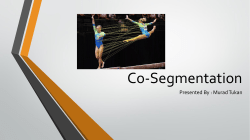
Fine-Grained Recognition without Part Annotations
Fine-Grained Recognition without Part Annotations: Supplementary Material
Jonathan Krause1
Hailin Jin2
1
Stanford University
Jianchao Yang2
2
Adobe Research
{jkrause,feifeili}@cs.stanford.edu
1. Network Architecture Comparison on cars196
Li Fei-Fei1
{hljin,jiayang}@adobe.com
Method
R-CNN [1]
R-CNN+ft
CNN+GT BBox
CNN+GT BBox+ft
PD+DCoP+flip
PD+DCoP+flip+ft
PD+DCoP+flip+GT BBox+ft
In the main text we showed that large gains from using
a VGGNet [5] architecture on the CUB-2011 [6] dataset.
We show a similar comparison on the cars-196 [3] dataset
in Tab. 1. As before, using a VGGNet architecture leads to
large gains. Particularly striking is the gain from fine-tuning
a VGGNet on cars-196 – a basic R-CNN goes from 57.4%
to 88.4% accuracy only by fine-tuning, much larger than the
already sizeable gain from fine-tuning a CaffeNet [2].
CNN Used
[2]
[5]
51.0 57.4
73.5 88.4
53.9 59.9
75.4 89.0
65.8 75.9
81.3 92.6
81.8 92.8
2. Additional Visualizations
Table 1. Analysis of variations of our method on cars-196, comparing performance when using a CaffeNet [2] versus a CNN with
a VGGNet architecture [5]. Performance is measured in 196-way
accuracy.
The visualizations in this section are expanded versions
of figures from the main text.
still have imperfections.
2.1. Pose Nearest Neighbors
2.3. Co-segmentation
In Fig. 1 we show more examples of nearest neighbors
using conv4 features, which is our heuristic for measuring
the difference in pose between different images (cf. Fig. 4
of the main text). In most cases the nearest neighbors of
an image come from a variety of fine-grained classes and
tend to have similar poses, justifying their use as a heuristic.
In cases where there are potentially many instances with
similar poses (e.g. first row, third column, or fifth row, first
column), the nearest neighbors may share more than just
pose. This heuristic still works reasonably when the pose is
relatively unusual (third row, first column, and fourth row,
third column), although occasionally small pose differences
persist (direction of the head in the third row, third column).
We show additional qualitative co-segmentation results
in Fig. 3 to supplement the results in Fig. 6 of the main
text. In general, co-segmentation works quite well, but in
cases where part of the background is sufficiently different
from the rest of the background the segmentation quality
can suffer. Segmentation is also difficult at certain car parts,
e.g. the wheels, since they look very different from the rest
of the car. It is also difficult to properly segment the bottom
of many cars, since the shadow of the car often looks similar
to the foreground.
References
[1] R. Girshick, J. Donahue, T. Darrell, and J. Malik. Rich feature hierarchies for accurate object detection and semantic
segmentation. In Computer Vision and Pattern Recognition,
2014. 1
[2] Y. Jia, E. Shelhamer, J. Donahue, S. Karayev, J. Long, R. Girshick, S. Guadarrama, and T. Darrell. Caffe: Convolutional architecture for fast feature embedding. arXiv preprint
arXiv:1408.5093, 2014. 1
[3] J. Krause, M. Stark, J. Deng, and L. Fei-Fei. 3d object representations for fine-grained categorization. In International
Conference on Computer Vision Workshops (ICCVW), pages
554–561. IEEE, 2013. 1
2.2. Foreground Refinement
Additional examples of images where the foreground refinement (cf. Sec. 3.1 and Fig. 3 of the main text) changes
the segmentation are given in Fig. 2. Most errors in a
GrabCut[4]+class model which can be corrected by a foreground refinement are undersegmentations. In the most
extreme case, these undersegmentations can actually be
empty, which the foreground refinement fixes. In all cases
the segmentation after refinement is better than the segmentation before refinement, though the final segmentation may
1
conv4 neighbors
Figure 1. Additional visualizations for nearest neighbors with conv4 features, which tend to preserve pose.
[4] C. Rother, V. Kolmogorov, and A. Blake. Grabcut: Interactive foreground extraction using iterated graph cuts. In ACM
Transactions on Graphics (TOG), volume 23, pages 309–314.
ACM, 2004. 1
[5] K. Simonyan and A. Zisserman. Very deep convolutional
networks for large-scale image recognition. arXiv preprint
arXiv:1409.1556, 2014. 1
[6] C. Wah, S. Branson, P. Welinder, P. Perona, and S. Belongie.
The caltech-ucsd birds-200-2011 dataset. 2011. 1
2
no refinement with refinement
no refinement with refinement
no refinement with refinement
Figure 2. Additional visualizations for the effect of foreground refinement. Within each column of images, the first image is the original
image, the second is the GrabCut+class model, and the third is GrabCut+class+refine.
Figure 3. Additional visualizations of co-segmentation results. The last results in each row are failure cases.
3
© Copyright 2025















